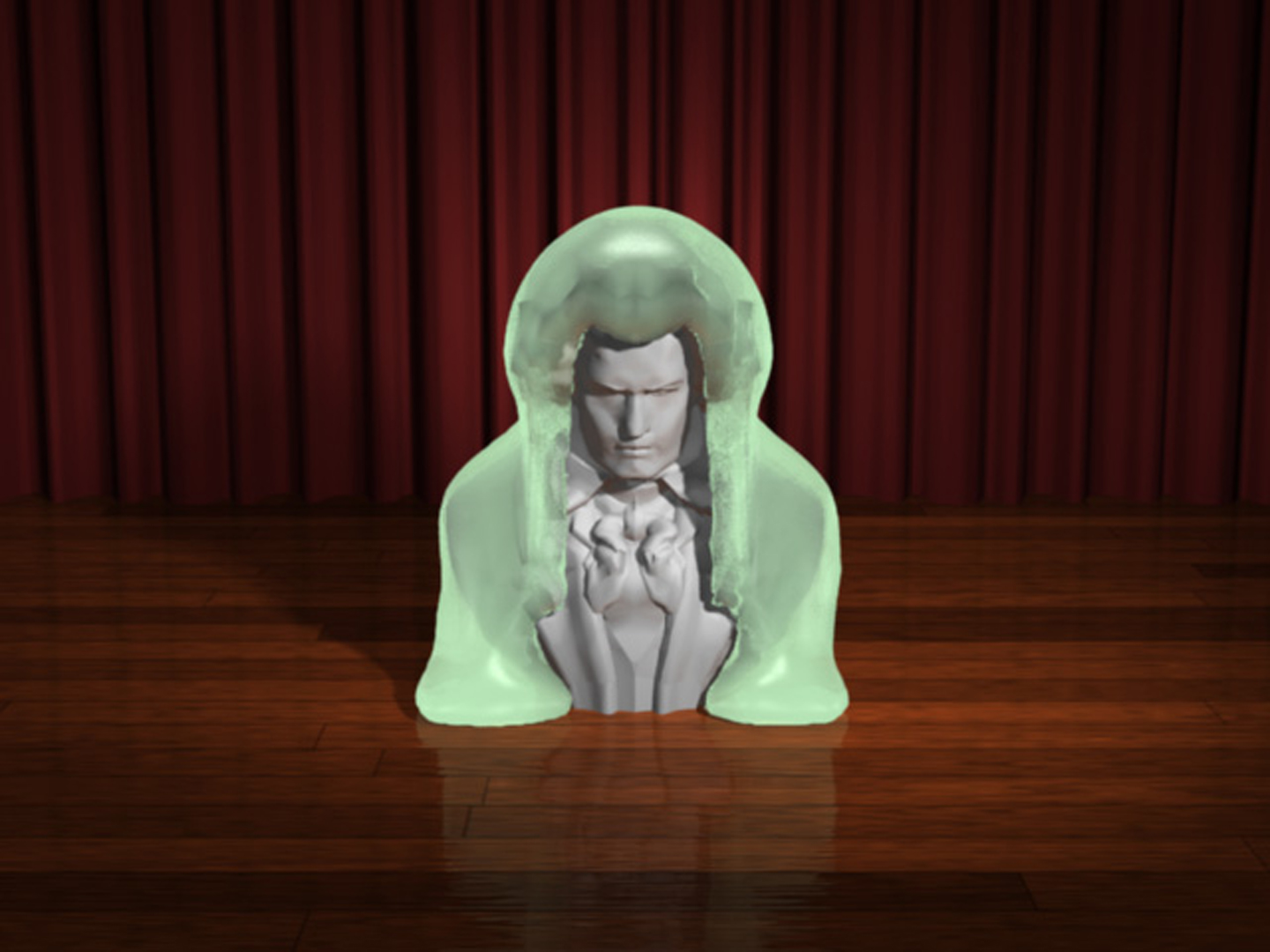“A method for animating viscoelastic fluids” by Goktekin, Bargteil and O’Brien
Conference:
Type(s):
Title:
- A method for animating viscoelastic fluids
Presenter(s)/Author(s):
Abstract:
This paper describes a technique for animating the behavior of viscoelastic fluids, such as mucus, liquid soap, pudding, toothpaste, or clay, that exhibit a combination of both fluid and solid characteristics. The technique builds upon prior Eulerian methods for animating incompressible fluids with free surfaces by including additional elastic terms in the basic Navier-Stokes equations. The elastic terms are computed by integrating and advecting strain-rate throughout the fluid. Transition from elastic resistance to viscous flow is controlled by von Mises’s yield condition, and subsequent behavior is then governed by a quasi-linear plasticity model.
References:
1. BIRD, R. B., ET AL. 1987. Dynamics of Polymeric Liquids. John Wiley & Sons, New York.Google Scholar
2. BONITO, A., PICASSO, M., AND LASO, M. 2003. Numerical simulation of 3D viscoelastic flows with free surfaces. Submitted to Journal Non-Newtonian Fluid Mechanics. Preprint.Google Scholar
3. CANI, M.-P., AND DESBRUN, M. 1997. Animation of deformable models using implicit surfaces. IEEE Transactions on Visualization and Computer Graphics 3, 1 (Jan.), 39–50. Google ScholarDigital Library
4. CARLSON, M., MUCHA, P. J., III, R. B. V. H., AND TURK, G. 2002. Melting and flowing. In the ACM SIGGRAPH 2002 Symposium on Computer Animation, 167–174. Google ScholarDigital Library
5. DESBRUN, M., AND CANI, M.-P. 1996. Smoothed particles: A new paradigm for animating highly deformable bodies. In Computer Animation and Simulation 1996, 61–76. Google ScholarDigital Library
6. DESBRUN, M., AND GASCUEL, M.-P. 1995. Animating soft substances with implicit surfaces. In the Proceedings of SIGGRAPH 95, 287–290. Google ScholarDigital Library
7. ENRIGHT, D. P., MARSCHNER, S. R., AND FEDKIW, R. P. 2002. Animation and rendering of complex water surfaces. In the Proceedings of ACM SIGGRAPH 2002, 736–744. Google ScholarDigital Library
8. ENRIGHT, D., LOSASSO, F., AND FEDKIW, R. 2004. A fast and accurate semi-Lagrangian particle level set method. Computers and Structures.Google Scholar
9. FOSTER, N., AND FEDKIW, R. 2001. Practical animation of liquids. In the Proceedings of ACM SIGGRAPH 2001, 23–30. Google ScholarDigital Library
10. FOSTER, N., AND METAXAS, D. 1996. Realistic animation of liquids. In Graphics Interface 1996, 204–212. Google ScholarDigital Library
11. FUNG, Y. C. 1965. Foundations of Solid Mechanics. Prentice-Hall, Englewood Cliffs, N.J.Google Scholar
12. GERRITSMA, M. I. 1996. Time dependent numerical simulations of a viscoelastic fluid on a staggered grid. PhD thesis, Rijksuniversiteit Groningen.Google Scholar
13. HAN, W., AND REDDY, B. D. 1999. Plasticity: Mathematical Theory and Numerical Analysis. Interdisciplinary Applied Mathematics. Springer-Verlag, New York.Google Scholar
14. HARLOW, F., AND WELCH, J. 1965. Numerical calculation of time-dependent viscous incompressible flow of fluid with a free surface. The Physics of Fluids 8, 2182–2189.Google ScholarCross Ref
15. HECKBERT, P. S. 1987. Ray tracing Jell-O brand gelatin. In the Proceedings of ACM SIGGRAPH 87, 73–74. Google ScholarDigital Library
16. MÜLLER, M., CHARYPAR, D., AND GROSS, M. 2003. Particle-based fluid simulation for interactive applications. In the ACM SIGGRAPH 2003 Symposium on Computer Animation, 154–159. Google ScholarDigital Library
17. NIXON, D., AND LOBB, R. 2002. A fluid-based soft-object model. IEEE Computer Graphics & Applications 22, 4 (July), 68–75. Google ScholarDigital Library
18. O’BRIEN, J. F., BARGTEIL, A. W., AND HODGINS, J. K. 2002. Graphical modeling and animation of ductile fracture. In the Proceedings of ACM SIGGRAPH 2002, 291–294. Google ScholarDigital Library
19. PREMOŽE, S., TASDIZEN, T., BIGLER, J., LEFOHN, A., AND WHITAKER, R. 2003. Particle-based simulation of fluids. Computer Graphics Forum 22, 3 (Sept.), 401–410.Google ScholarCross Ref
20. STAM, J. 1999. Stable fluids. In the Proceedings of ACM SIGGRAPH 99, 121–128. Google ScholarDigital Library
21. STORA, D., AGLIATI, P.-O., CANI, M.-P., NEYRET, F., AND GASCUEL, J.-D. 1999. Animating lava flows. In Graphics Interface 99, 203–210. Google ScholarDigital Library
22. TERZOPOULOS, D., AND FLEISCHER, K. 1988. Deformable models. The Visual Computer 4, 306–331.Google ScholarCross Ref
23. TERZOPOULOS, D., AND FLEISCHER, K. 1988. Modeling inelastic deformation: Viscoelasticity, plasticity, fracture. In the Proceedings of ACM SIGGRAPH 88, 269–278. Google ScholarDigital Library
24. TERZOPOULOS, D., PLATT, J., AND FLEISCHER, K. 1989. Heating and melting deformable models (from goop to glop). In Graphics Interface 1989, 219–226.Google Scholar
25. TOMÉ, M., MANGIAVACCHI, N., CUMINATO, J., CASTELO, A., AND MCKEE, S. 2002. A finite difference technique for simulating unsteady viscoelastic free surface flows. Journal of Non-Newtonian Fluid Mechanics 106, 61–106.Google ScholarCross Ref





